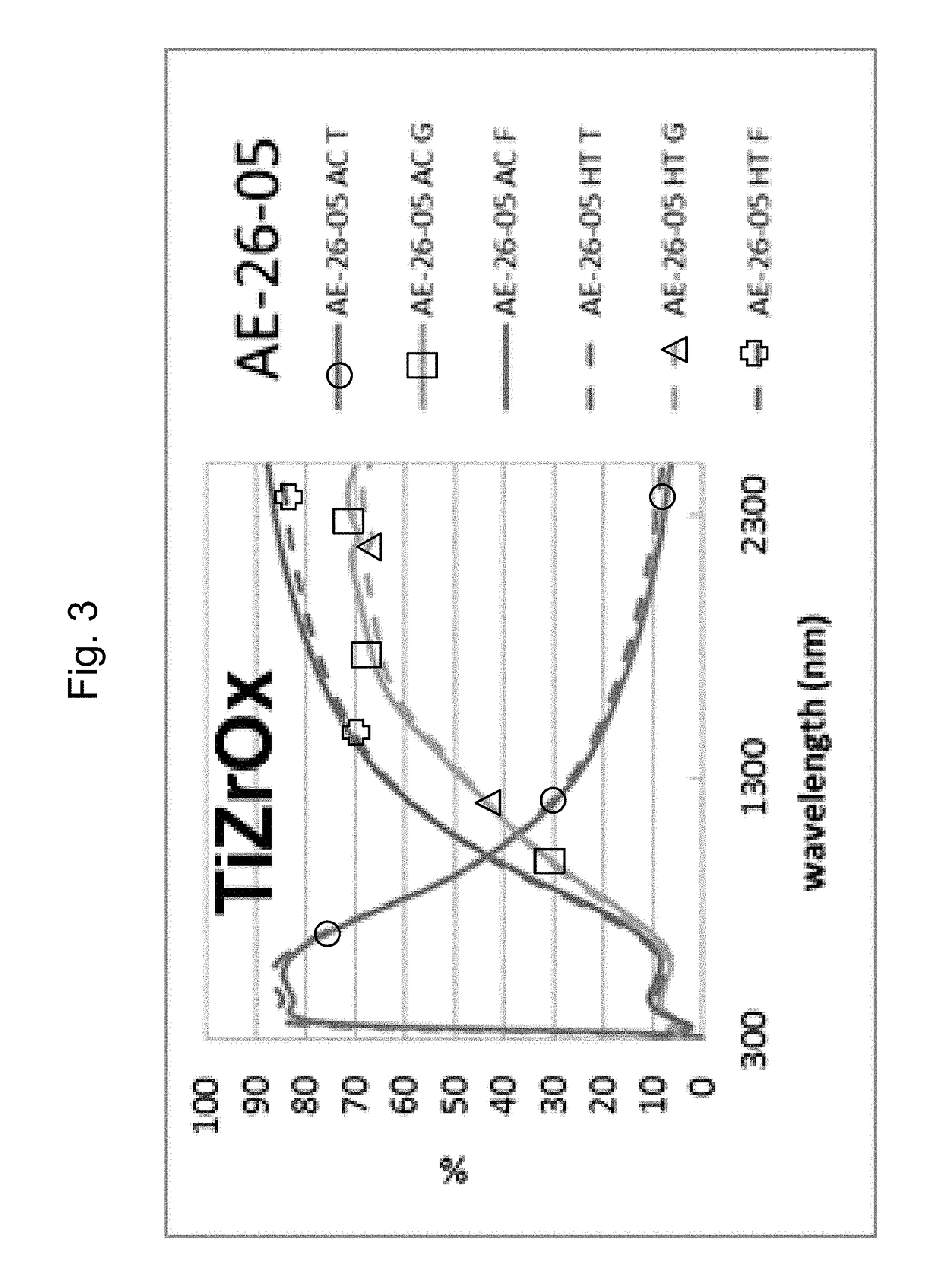Coated article having low-e coating with ir reflecting layer(s) and doped titanium oxide dielectric layer(s) and method of making same
a technology of ir reflecting layer and titanium oxide dielectric layer, which is applied in the direction of vacuum evaporation coating, coating, sputtering coating, etc., can solve the problems of thermal or lattice stress, thermal stability of materials, and typically not heat stable, and achieve high refractive index (n), and low e stack performance deterioration
- Summary
- Abstract
- Description
- Claims
- Application Information
AI Technical Summary
Benefits of technology
Problems solved by technology
Method used
Image
Examples
example 1
[0043]Example 1 was a low-E coating on a glass substrate according to the FIG. 1 embodiment, for comparing to FIG. 2 above. The Example 1 layer stack was glass / Ti SnOx(27 nm) / ZnO(4 nm) / Ag(11 nm) / NiTiNbOx(2.4 nm) / ZnSnO(10 nm) / ZnO(4 nm) / SiN(10 nm), where the ZnO layers were doped with Al. Example 1 was the same coating stack as the Comparative Example (CE) described above regarding FIG. 2, except that in Example 1 the TiO2 layer of the CE was replaced with Sn-doped titanium oxide (TiSnOx). The high index layer 2 was titanium oxide doped with tin (TiSnOx) in Example 1. The oxygen depleted atmosphere in which the TiSnOx layer 2 was sputter deposited contained 20% oxygen gas and 80% argon gas (4 sccm O2 and 16 sccm Ar). Power applied to the Ti target was 500 W, and power applied to the Sn target was 50 W. Metal content of the TiSnOx layer 2 was 88% Ti and 12% Sn (atomic %). The coating of Example 1 had a normal emissivity (En) of 0.068. The TiSnOx layer 2 of Example 1 had a refractive in...
example 2
[0045]Example 2 (FIG. 5) had the same layer stack as Example 1 (FIGS. 4 and 6) above, with the sole difference being that the TiSnOx layer 2 in Example 2 was sputter deposited in a gaseous atmosphere containing 70% oxygen gas whereas the TiSnOx layer 2 in Example 1 was sputter depositing in a gaseous atmosphere containing 20% oxygen gas. The high index layer 2 was titanium oxide doped with tin (TiSnOx) in both of Examples 1-2. The oxygen depleted atmosphere in which the TiSnOx layer 2 was sputter deposited in Example 1 contained 20% oxygen gas and 80% argon gas (4 sccm 02 and 16 sccm Ar), but in Example 2 the atmosphere was modified to contain 70% oxygen gas and 30% argon gas (14 sccm O2 and 6 sccm Ar). Power applied to the Ti and Sn targets, the HT, and the metal content of the layer 2, were all the same in Examples 1 and 2. It can be seen by comparing FIG. 5 (Example 2 with 70% oxygen gas in sputtering atmosphere) to FIG. 6 (Example 1 with 20% oxygen gas in sputtering atmosphere),...
example 3
[0046]Example 3 was a low-E coating on a glass substrate according to the FIG. 1 embodiment, for comparing to FIG. 2 above. The Example 3 layer stack was glass / TiYOx(27 nm) / ZnO(4 nm) / Ag(11 nm) / NiTiNbOx(2.4 nm) / ZnSnO(10 nm) / ZnO(4 nm) / SiN(10 nm), where the ZnO layers were doped with Al. Example 3 was the same coating stack as Example 1 and the Comparative Example (CE) described above regarding FIG. 2, except that in Example 3 the high index layer 2 was Y-doped titanium oxide (TiYOx). The high index layer 2 was titanium oxide doped with yttrium (TiYOx) in Example 3, and sputter deposited in an oxygen depleted atmosphere. Metal content of the TiYOx layer was 95% Ti and 5% Sn (atomic %). The composition ratio of the TiYOx was Y:Ti:O corresponding to 5:95:245 (atomic). The TiYOx layer 2 of Example 3 had a refractive index (n), at 550 nm, of 2.42. FIG. 9 shows the data of Example 3, before and after HT, and should be compared to the CE of FIG. 2. In FIGS. 2 and 9 at the right side where th...
PUM
| Property | Measurement | Unit |
|---|---|---|
| refractive index | aaaaa | aaaaa |
| refractive index | aaaaa | aaaaa |
| refractive index | aaaaa | aaaaa |
Abstract
Description
Claims
Application Information
 Login to View More
Login to View More - R&D
- Intellectual Property
- Life Sciences
- Materials
- Tech Scout
- Unparalleled Data Quality
- Higher Quality Content
- 60% Fewer Hallucinations
Browse by: Latest US Patents, China's latest patents, Technical Efficacy Thesaurus, Application Domain, Technology Topic, Popular Technical Reports.
© 2025 PatSnap. All rights reserved.Legal|Privacy policy|Modern Slavery Act Transparency Statement|Sitemap|About US| Contact US: help@patsnap.com



